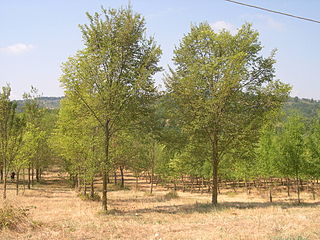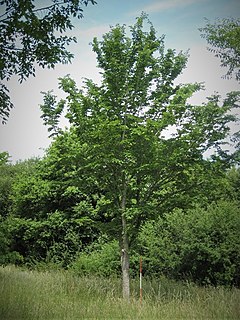
Ulmus 'San Zanobi' is a hybrid elm cultivar raised by the Istituto per la Protezione delle Piante (IPP) in Florence, from a crossing of the Dutch hybrid 'Plantyn' and the Siberian Elm Ulmus pumila clone 'S 15'; it was released to commerce in 2002. 'San Zanobi' was introduced to the UK in 2004 by Hampshire & Isle of Wight Branch, Butterfly Conservation, as part of its assessment of DED-resistant cultivars as potential hosts of the endangered White-letter Hairstreak.

Ulmus 'Plinio' is a hybrid elm cultivar derived from a crossing of the Dutch cultivar 'Plantyn' with the Siberian Elm Ulmus pumila clone 'S.2'. 'Plinio' was raised by the Istituto per la Protezione delle Piante (IPP), in Florence and released for sale in 2003. 'Plinio' was introduced to the UK in 2004 by Hampshire & Isle of Wight Branch, Butterfly Conservation, as part of its assessment of DED-resistant cultivars as potential hosts of the endangered White-letter Hairstreak.

Ulmus davidiana var. japonica, the Japanese elm, is one of the larger and more graceful Asiatic elms, endemic to much of continental northeast Asia and Japan, where it grows in swamp forest on young alluvial soils, although much of this habitat has now been lost to intensive rice cultivation.

Ulmus 'Nanguen' is a complex fourth generation Dutch hybrid cultivar raised at the Dorschkamp Research Institute for Forestry & Landscape Planning, Wageningen. Lutèce was derived from the cross 'Plantyn' ×, an ancestry comprising four field elms, a wych elm, the curious Exeter Elm ('Exoniensis'), and a frost-resistant selection of the Himalayan elm.

Ulmus 'New Horizon' is an American hybrid cultivar raised by the Wisconsin Alumni Research Foundation (WARF), from a crossing of the Japanese Elm clone W43-8 = 'Reseda' with Siberian Elm clone W426 grown from seed collected from a street tree at Yankton, South Dakota. Tested in the US National Elm Trial coordinated by Colorado State University, 'New Horizon' averaged a survival rate of 74% after 10 years.'New Horizon' was patented in the US in 1994, while in Europe, it is marketed as one of the 'Resista' elms protected under EU breeders' rights.

Ulmus laciniata(Trautv.) Mayr, known variously as the Manchurian, cut-leaf, or lobed elm, is a deciduous tree native to the humid ravine forests of Japan, Korea, northern China, eastern Siberia and Sakhalin, growing alongside Cerciphyllum japonicum, Aesculus turbinata, and Pterocarya rhoifolia, at elevations of 700–2200 m, though sometimes lower in more northern latitudes, notably in Hokkaido.

Ulmus 'Sapporo Autumn Gold' is one of the most commercially successful hybrid elm cultivars ever marketed, widely planted across North America and western Europe, although it has now been largely supplanted by more recent introductions. Arising from a chance crossing of the Japanese elm and Siberian elm, seed was sent in 1958 by Prof. Nobuku Takahashi and his colleagues at the Sapporo Botanical Garden of Hokkaido University, Sapporo, to Eugene Smalley at the University of Wisconsin–Madison. The patent issued in 1975 has expired, and there are now no propagation restrictions.

Ulmus 'Wanoux' is a Dutch hybrid cultivar raised at the Dorschkamp Research Institute for Forestry & Landscape Planning, Wageningen, from an open pollination of 'Plantyn'. Originally identified as clone No. 762, it was selected for assessment by the French Institut National de la Recherche Agronomique (INRA), which patented it as 'Wanoux' in 2006.

Ulmus 'Columella' is a Dutch elm cultivar raised by the Dorschkamp Research Institute for Forestry & Landscape Planning, Wageningen, from a selfed or openly pollinated seedling of the hybrid clone 'Plantyn' sown in 1967. It was released for sale in 1989 after proving extremely resistant to Dutch elm disease following inoculation with unnaturally high doses of the pathogen, Ophiostoma novo-ulmi. However, propagated by grafting onto Wych Elm rootstocks, graft failure owing to incompatibility has become a common occurrence in the Netherlands.

The Japanese Elm cultivar Ulmus davidianavar.japonica 'Jacan' is a cold-resistant selection from Canada. The tree was raised by the Morden Research Station, Morden, Manitoba in the 1980s.

The American elm cultivar Ulmus americana 'Lewis & Clark' is a development from the North Dakota State University (NDSU) Research Foundation breeding programme, released in 2004 to commemorate the 200th anniversary of the eponymous expedition. The cultivar was cloned from a tree discovered in 1994 along the Wild Rice River south west of Fargo, North Dakota, where all those around it had succumbed to Dutch elm disease; the tree remains in perfect health (2008). Prairie Expedition proved only moderately successful in the US National Elm Trial, averaging a survival rate of 62.6% overall, potentially due to environmental factors rather than susceptibility to Dutch elm disease.

Ulmus 'Arno' is an Italian hybrid cultivar derived from a crossing of 'Plantyn' with the Siberian Elm Ulmus pumila clone S.2. It was raised by the Istituto per la Protezione delle Piante (IPP) in Florence, and released in 2007. However, 'Arno' was not a commercial success; propagation had ceased by 2010, and it is no longer patent protected.

Ulmus 'Fiorente' is a hybrid cultivar elm derived from a crossing of the Siberian Elm Ulmus pumila clone 'S.10' from Lucca, Italy, with the Ulmus minor clone 'C.02' from Lungarno, Florence, by the Istituto per la Protezione delle Piante (IPP), part of the Italian National Research Council, in Florence. 'Fiorente' was patented in 2006, and released to commerce in 2012.

Ulmus 'Morfeo' is a hybrid elm cultivar raised by the Istituto per la Protezione delle Piante (IPP), Florence, in 2000. 'Morfeo' arose from a crossing of the Dutch hybrid clone '405' and the Chenmou Elm, the latter a small tree from the provinces of Anhui and Jiangsu in eastern China, The '405' clone is a full sister of 'Groeneveld', a crossing of an English U. × hollandica and a French U. minor from the Barbier Nursery, Orléans.

The field elm cultivar Ulmus minor 'Ademuz' was cloned by root cuttings from a tree assumed to be growing in or near the eponymous town 100 km north-west of Valencia, Spain. The tree was discovered in 1996 by Margarita Burón of the Escuela Técnica Superior de Ingenieros de Montes, Universidad Politėcnica de Madrid (UPM). 'Ademuz' is one of a number of U. minor clones found to have a very high resistance to Dutch Elm Disease, on a par with, if not greater than, the hybrid cultivar 'Sapporo Autumn Gold' grown as a control. In the Madrid study, the appearance of the tree was rated 4.5 / 5, the most attractive of the seven selected cultivars.

The field elm cultivar Ulmus minor 'Dehesa de Amaniel' was raised from seed collected in 1999 from a tree growing in the Dehesa de la Villa park, within the Moncloa-Aravaca district of north-west Madrid by researchers at the Escuela Técnica Superior de Ingenieros de Montes, Universidad Politėcnica de Madrid. 'Dehesa de Amaniel' is one of a number of Spanish Ulmus minor found to have a very high resistance to Dutch Elm Disease, on a par with, if not greater than, the hybrid cultivar 'Sapporo Autumn Gold'.

The Field Elm cultivar Ulmus minor 'Dehesa de la Villa' was cloned by root cuttings from a tree growing in the eponymous park within the Moncloa-Aravaca district of north-west Madrid, by researchers at the Escuela Técnica Superior de Ingenieros de Montes, Universidad Politėcnica de Madrid in 1990.

The field elm cultivar Ulmus minor 'Majadahonda' was cloned by grafting scions from a tree found growing in the suburb of Majadahonda, 16 km north-west of Madrid, by researchers at the Escuela Técnica Superior de Ingenieros de Montes, Universidad Politėcnica de Madrid in 1993. The tree is one of a number found to have a very high resistance to Dutch Elm Disease, on a par with, if not greater than, the hybrid cultivar 'Sapporo Autumn Gold'. In the Madrid study, the appearance of the tree was rated 4.1 / 5.

The cultivar Ulmus 'Fuente Umbria' was raised from seed collected in 1995 from an elm resembling Ulmus minor growing in a field at Fuente Umbria west of Valencia, by researchers at the Escuela Técnica Superior de Ingenieros de Montes, Universidad Politėcnica de Madrid. 'Fuente Umbria' is one of seven cultivars found to have a very high resistance to Dutch Elm Disease, on a par with, if not greater than, the hybrid cultivar 'Sapporo Autumn Gold'. However, retrospective DNA analysis has revealed that the clone has Ulmus pumila DNA, the species introduced to Spain at the end of the 16th century, and has consequently been dropped from the programme.

The Field Elm cultivar Ulmus minor 'Retiro' was raised from seed collected in 2002 from a tree growing in the El Retiro park, in the centre of Madrid by researchers at the Escuela Técnica Superior de Ingenieros de Montes, Universidad Politėcnica de Madrid.




















